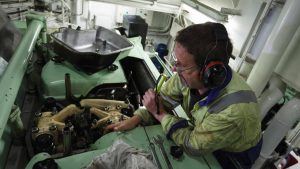What is Maintenance?
The technical meaning of “maintenance” involves functional checks, servicing, repairing or replacing of necessary devices, equipment, machinery and supporting utilities in industrial and residential installations.
Objectives of Maintenance
- Minimize loss of productive time
- Minimize repair time & cost
- Keep productive assets in working condition
- Minimize accidents
- Minimize total maintenance cost
- Improve the quality of products

Types of Maintenance
There are main 3 types of Maintenance:
- Breakdown maintenance or reactive maintenance
- Preventive maintenance or planned maintenance
- Predictive maintenance or condition-based maintenance
- Breakdown maintenance or reactive maintenance
- It is performed when a machine part breaks down suddenly.
- It becomes a repair work
- Since there is no plan for the machinery maintenance works, to control the maintenance cost is not possible in this type of maintenance.
- It is not suitable for marine vessels
- For example, replacing the engine system lub oil when it is fully contaminated or degraded
Advantages
- Low cost
- Less manpower
Disadvantages
- Increased cost due to unplanned downtime of equipment
- Cost involved with repair or replacement of equipment.
- Inefficient use of staff resources.
- Preventive maintenance or planned maintenance
- It is performed regularly on a machinery as a Planned Maintenance System (PMS) to lessen machinery failure
- It is performed while the machine is still working and so avoid unexpected breakdown of machinery.
- It’s safe but maintenance cost is very high.
- For example, replacing the engine system lub oil after completion of running hours according to PMS/ maker’s instruction
There are few basic activities associated with preventive maintenance:
- Inspections: damage, alignment, leaks, cracks, etc.
- Servicing: alignment, clearing or replacing filters, and verifying sensor operation
- Lubrication: topping off oils or other fluids and at times flushing and replacing the fluid
- Fastening: Periodical checks for fastening system for its proper location and alignment.
Figure: Flow Chart of Preventive Maintenance
Advantages:
- Cost effective during the capital investment processes.
- Increased component life
- Energy savings
- Reduces equipment or process failure
- Estimated 12% to 18% cost savings over breakdown maintenance program [2]
Disadvantages:
- Catastrophic failures still likely to occur due to lack of condition monitoring
- Labor intensive
- Potential for dropping of performance for unneeded maintenance.
- Potential for incidental damage to components
during conducting unneeded maintenance
- Predictive maintenance or condition-based maintenance
- It’s an advanced scientific technique to maximize operating time and minimize unnecessary work.
- Conditions of the machinery can be measured continuously and this enables the maintenance team to plan for an overhauling.
- In this maintenance lab analysis method, sensitive instruments and computerized control system are used to predict troubles.
- For example, replacing the engine system lub oil on basis of laboratory analysis report and instructions
Figure: Flow Chart of Predictive Maintenance
It monitors the condition of equipment or systems to detect/trend the degradation. Techniques include:
- Vibration monitoring
- Thermographic inspection
- Oil analysis
- Visual inspection
- Ultrasonic leak detectors
- Electrical insulation:
- Megger tests
- Surge comparison
- Performance testing
- Wear and dimensional measurements
- Nondestructive testing
- Ultrasonic
- Borescope inspections
- Eddy current performance
Advantages
- Increased component operational life/availability
- Allows for preemptive corrective actions
- Decrease in machinery downtime
- Decrease in costs for parts and labor
- Better product quality
- Improved worker and environmental safety
- Improved worker morale
- Energy savings
- Estimated 25% to 30% cost savings over breakdown maintenance and 8% to 12% over preventive maintenance
Disadvantages
- Increased investment in diagnostic equipment.
- Increased investment in staff training.
Difference between the Preventive Maintenance and Predictive maintenance